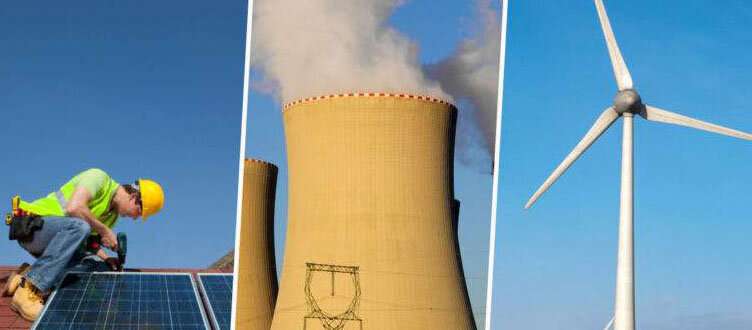The scenario chosen by the scientists combines wind and solar power and does not include nuclear power. Credit: UNIGE - Empa
How can we reduce the carbon footprint of electricity consumption in Switzerland? The country relies on electricity imports from fossil fuel power plants, which are major emitters of greenhouse gases. A team of researchers from the University of Geneva (UNIGE) and the Swiss Federal Laboratories for Materials Testing and Research (Empa) has studied various scenarios for reducing the Swiss carbon footprint tied to electricity consumption. To achieve this while meeting future electrification needs, the author recommend besides importing electricity the implementation of a domestic generation mix of wind and photovoltaic energy. All of this without using nuclear energy. This scenario would enable Switzerland to reduce its contribution to global greenhouse gas emissions by an estimated 45 percent. These results can be found in Energy Policy.
The increase of greenhouse gases in the atmosphere is the main drivers of global warming. A significant proportion of these gases are caused by the fossil fuel power plants used for electricity production. It is estimated that these power plants generate a quarter of the total GHG emissions in Europe. In Switzerland, where electricity is mainly produced by nuclear and hydroelectric power plants, this production accounts for 2 percent of greenhouse gas emissions.
However, it is oftentimes economically attractive to sell and export parts of generated energy to neighboring countries. Switzerland therefore also relies on imports to meet its needs. This represents 11 percent of the electricity consumed. The electricity therefore originates from power stations that are highly "carbon intensive." A scientific team from the UNIGE and Empa has developed various energy scenarios and defined the best path to follow to decarbonise Switzerland. This means reducing the country's consumption of primary energy sources that emit greenhouse gases.
"We developed seven different scenarios that include solar, wind and hydro power energy with varying degrees. All of this with and without the use of nuclear power as Switzerland envisages a gradual withdrawal from this mode of production by 2050," explains Elliot Romano, a senior scientist in the F.-A. Forel Department of Environmental and Water Sciences at the UNIGE Faculty of Science. The researchers also took into account the possibilities of supply from abroad, which are essential to meet demand, as well as the population's need for electrification of mobility and heating.
Reduced imports
After examining the various options, the research team determined that the optimal scenario would be a mix of photovoltaic and wind generation. "This mix is the most efficient way to reduce the country's footprint but it is also the best alternative to nuclear power," says Martin Rüdisüli, a researcher at Empa's Urban Energy Systems Laboratory and the study's first author. The model is based on a large wind power production of 12 TWh and solar power production of 25 TWh. By way of comparison, in Switzerland, solar power will generate 2.72 TWh and wind power 0.13 TWh in 2021. Compared to a nuclear power solution, the proposed production mix reduces the import requirement from 16 TWh to 13.7 TWh.
On the other hand, this scenario—which also takes into account future electricity needs related to electric mobility and thermal needs of buildings—would increase the carbon footprint of consumption from 89g of CO2 per kWh (in 2018) to 131g of CO2 per kWh in the future. However, the electrification of these needs as a whole would ultimately reduce Switzerland's contribution to global greenhouse gas emissions by 45 percent. The researchers also showed that the current storage facilities would only be able to partially manage the summer electricity surpluses, which would result from the large capacity of the photovoltaic power plants in operation at the time.
Unprecedentedly accurate data
"Until now, research on the footprint of electricity production has been based on average consumption values, particularly annual values. The strength of our study lies in the use of hourly values and therefore much more precise," explains Elliot Romano. The direct but also the indirect footprint of this production was also integrated. "We took into account the footprint generated, for example, by the production of the concrete used in the construction of a power plant. This method, therefore, enabled us to carry out a comprehensive analysis of the life cycle of electricity production."
This method and the unprecedentedly precise data provide concrete guidelines for Switzerland's 2050 energy strategy. It also opens the way for new scientific studies.
More information: Martin Rüdisüli et al, Decarbonization strategies for Switzerland considering embedded greenhouse gas emissions in electricity imports, Energy Policy (2022). DOI: 10.1016/j.enpol.2022.112794
Journal information: Energy Policy
Provided by University of Geneva























